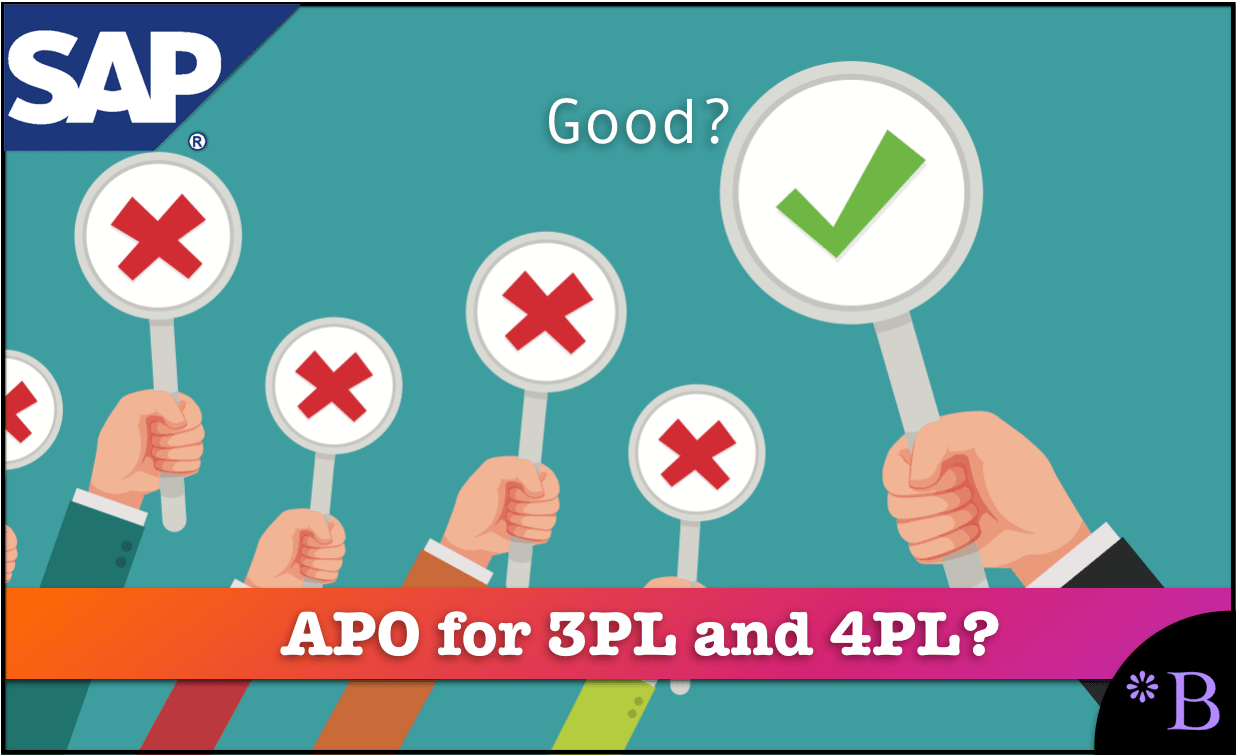How Good are the SAP Solutions for 3PL and 4PL?
Executive Summary
- SAP’s 3 PL and 4 PL solutions in the SAP APO suite are extremely problematic.
- There are important trade-offs and costs and complexity with SAP APO.

Introduction into the Solutions for 3 PL and 4 PL
One question the sometimes comes up is whether SAP offers an efficient solution for 4 PL logistics companies. SAP has tried to target the transportation and warehousing space and therefore 4 PL providers. So how appropriate is APO for 4 PL logistics companies? In this article, written by a long-term SAP APO consultant, we explain what the fit actually is, as well as how well APO is currently implemented in this area, as well as the positives and negatives of using APO for this purpose.
See our references for this article and related articles at this link.
4 PL Logistics Companies The SAP APO Suite
The SAP APO suite has some modules that provide functionality for advanced planning and execution. This suite has many installations in finished goods manufacturers. SAP has made some enhancements in the past several years which address the transportation, warehousing, and supply chain monitoring areas of the suite that have been marketed to the traditional SAP APO customer base (finished goods manufacturers).
- SAP has made some enhancements in the past several years which address the transportation, warehousing, and supply chain monitoring areas of the suite that have been marketed to the traditional SAP APO base, which is finished goods manufacturers. However, different parts of the suite can be installed at various companies, and very few if any companies install the entire suite. The transportation, warehousing, and supply chain monitoring areas of the suite, while previously lagging the manufacturing and demand planning areas of the suite are now up to the point that they can be considered by at least 3PLs.
(There are extremely few 4PLs currently) A combination of the following modules would be appropriate for a 3PL.
TPVS or TM – Transportation Planning and Vehicle Scheduling
-
- This is a traditional TMS. This application is a minimum of a million dollars just for the software license. This puts it at the top end in terms of cost of TMS systems. TMS is currently merging with freight marketplace functionality and SAP TM is very much focused on things like internal route optimization rather than the freight marketplace side of the equation
EWM – Extended Warehouse Management
-
- This offers advanced warehouse management functionality. EWM was developed at CAT Logistics and is designed for a large scale outsourced provider. Therefore it is really directed at the 3PL and 4 PL market, even though SAP and their consulting partners often try to sell EWM into shippers.
EM – Event Management
- This is a status system that can be used to create a notification system for when things occur in the supply network.
Trade-Offs of Cost and Complexity with SAP APO
SAP is a complex and expensive implementation. However, SAP has the advantage of being consistent with the software that many finished goods manufacturers have or are currently implementing. A 3PL that had an operational implementation of TPVS-EWM-EM would be very attractive to companies that were running either SAP ERP. This is because it would allow for easier integration (both technical and terminology and operating philosophy) between the finished goods manufacturer and 3PL systems.
On the other hand, SAP does not play well with other applications. SAP uses this lack of ability to interoperate as an excuse to get companies to simply buy more SAP.
SAP is still very much a closed system. The new user interface, called Fiori has close to no screens for the modules discussed here. 4 PL logistics companies need a high degree of collaboration ability, and APO does not have this. SNC, which is a collaboration module, is lightly installed and does not relate at all to 4PL providers.
SAP APO modules are virtually never implemented unless the company already owns SAP’s flagship ERP system. ERP systems are designed for companies that manufacture items. 4PL providers do not manufacture anything. Therefore they may be better suited to using best of breed financial applications like those offered by FinancialForce and Intacct and then connecting concentrated transportation and warehousing applications to them rather than going the ERP route.
What is the Cost?
But all of this comes at a cost. And on a cost per functionality basis, SAP APO does not offer enough targeted functionality for 4PL providers. Another disadvantage of SAP APO is that the businesses that implement APO are extremely expensive and have a way of over-billing clients. Because APO is rarely implemented in the transportation and logistics business, few of the consultants within the big APO implementors have consultants with experience in this industry.
Conclusion
4PL logistics companies should look for lightweight and cost-effective solutions on which to base their platform. SAP has few references in the transportation and warehousing space and has some high profile failures. But on the other hand, there can still be business drivers that cause one to use APO and even SAP in the 4 PL logistics space.